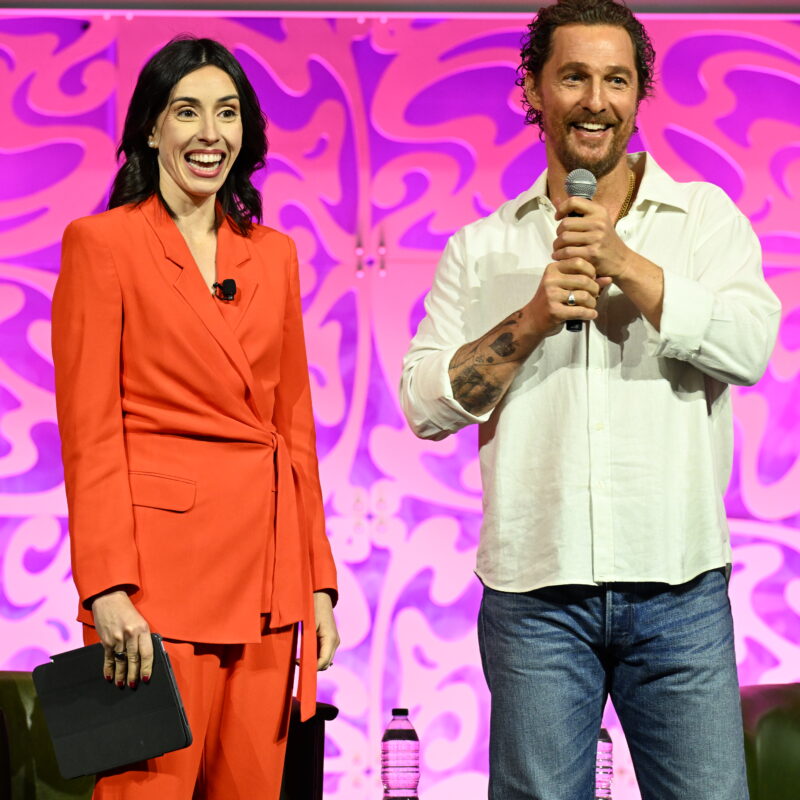From McConaughey to the C-Suite: How Great Leaders Use Story

When you think Matthew McConaughey, you probably hear that slow Texas drawl and the iconic “alright, alright, alright.”
But when I interviewed him at ATD’s International Conference last year, what I wasn’t fully prepared for was just how much charm he exudes in person—and how quickly he had me, an Australian and a proud former Rotary President, apologising for his infamous gap year in Warnervale, NSW.
If you’ve read his book Greenlights, you’ll know the story: no friends, six odd jobs, and a host family who seemed to think “cultural exchange” meant radio silence and Vegemite sandwiches.
He called it a “livin’ hell” – and yep, I felt the national shame – but interestingly, in response to my apology, he said it made him who he is.
Once we’d cleared the air about his Australian misadventures, McConaughey lit up the stage in the way only he can. No slides. No script. Just stories. And the whole room was spellbound.
I’ve shared his reflections on optimism before, but what I haven’t shared—and what feels especially urgent for leaders right now—is what he taught me about storytelling.
Because in an age of endless noise, overloaded inboxes, and one-too-many all-hands meetings… the ability to craft a message that connects. That moves people. That’s a leadership superpower we all need in our toolkit.

Why Should Leaders Care About Storytelling?
We’re not short on communication. We’re drowning in it. And yet connection and clarity? Still in short supply:
- 54% of leaders believe current communication methods are failing to engage their teams. (Gartner)
- Workers spend a staggering 88% of their week communicating, yet genuine connection and clarity remain elusive. (Grammarly)
- We waste 25 billion hours a year on noise: meetings, pings, messages that go nowhere. (Atlassian)
More words aren’t the answer. Better stories are.
Neuroscience gives us the proof: stories light up our brains in a way data simply doesn’t.
When we hear a good story, we get a powerful neurochemical mix:
- cortisol (attention)
- oxytocin (trust)
- dopamine (motivation)
It’s a chemical cocktail for connection and action. And it works. Stanford found that stories are 22x more memorable than standalone facts. Narrative-based communication increases persuasion by up to 50% and research shows storytelling strengthens bonds and supercharges collaboration.
Yuval Noah Harari put it brilliantly when we spoke last year at Energy Disruptors – he’s a big believer that you don’t change minds by dismantling someone’s existing narrative. You change minds by offering a better story to take its place.
And when the stakes are high—when you’re navigating change, uncertainty, or transformation—that’s when storytelling becomes mission-critical.The best leaders don’t just ask:
“What do I need to say?”
They ask:
“What story will make this matter?”
McConaughey’s 3 Storytelling Principles
So, what makes a story land? According to McConaughey, it’s not about theatrics – it’s about truth and presence.
- It’s got skin in the game—real stakes, real vulnerability.
- It’s told with joy, not just accuracy—because if you’re not into it, no one else will be.
- It makes room for silence—because sometimes the pause is where the point really hits.
1. Great storytelling is personal—but relatable
McConaughey says a story has to cost you something. That means there’s real vulnerability in it—something true, something felt. But it can’t be so self-involved that no one else can see themselves in it. Great stories hold up a mirror. People need to see themselves, someone they know, a past version of themselves, a future possibility.
“It has to be personal, but not so personal that you don’t let humanity in.”
It’s not about oversharing—it’s about opening a window others can see through.
My late friend Cal Wilson, the brilliant comedian, offered another powerful perspective on this: Audiences want to see your scars—but they don’t want to be confronted by your open wounds.
The most powerful stories leaders can tell aren’t polished highlight reels—or live therapy sessions. They’re reflections offered with generosity, wisdom, and enough distance that others can find strength in them too.
2. If you’re not enjoying the story, no one else will either
Boom. This is such a simple idea, but when you spend a moment reflecting on it, it’s so profoundly true. Name one time you listened to someone disinterestedly relay a story and felt drawn in… you can’t because you forgot it while you were in the conversation, let alone afterwards!
McConaughey talks about how joy in the telling is the invitation. The best storytellers don’t just recite—they relive.
“People love to watch someone enjoying telling their own story.”
Reminder to leaders: Enthusiasm > polish. Energy is magnetic. If you’re not lit up by what you’re saying, why should anyone else be?
Sidenote: Just because you’re excited about your story doesn’t mean it’s compelling. Enthusiasm helps, but it’s not a free pass. A good story isn’t just fun to tell—it has to land with the listener.
3. Trust the pause—the downbeat is where the punch lands
McConaughey urges storytellers to slow down and trust the silence before the insight. A good story has rhythm. And the pause—the “pregnant pause”—is what makes the punchline hit harder.
“It’s like music. You need the downbeat. That’s what makes the next note resonate.”
Most of us rush to fill every silence. But silence? That’s where attention sharpens.

Make it Stick, Make it Matter
I love a good framework—and let’s be honest, if it’s not easy to remember, we’re not using it.
This 3R method – Relevant, Resonant, Remembered – is a favourite of mine because it cuts straight to the heart of effective storytelling. While it’s not formally attributed to any one thinker, it builds on core principles you’ll find across influence theory, from Aristotle to Cialdini: know your audience, move them emotionally, and make it stick.
Every message—whether it’s a keynote, a team meeting, or a high-stakes pitch—should be:
Relevant: Connect to what your audience cares about
Ask yourself: “Why does this matter—to them, not just to me?” Not theoretically, but right now, in their world.
I noticed how McConaughey never assumes interest—he earns it. Every story starts with a hook that makes you think, “I need to hear this.” He’s masterful at answering the unspoken question: “Why should I care?”
Quick win: Before your next important communication, write down the three biggest priorities or pain points of your audience. Then explicitly connect your message to at least one of them in the first 30 seconds.
Resonant: Make it emotionally true, not just factually accurate
Facts inform, but emotions drive action. Your data might be perfect, but if there’s no feeling behind it, it won’t stick.
What struck me about McConaughey was how he prioritises emotional truth. He’s not just sharing information—he’s sharing experience. And that’s what makes us lean in.
Quick win: Identify the core feeling you want your message to evoke. Is it urgency? Hope? Concern? Pride? Make sure your tone, examples, and energy align with that emotion.
As Maya Angelou said: “People will forget what you said, people will forget what you did, but people will never forget how you made them feel.”
Remembered: Give them something sticky to take away
The ultimate test of communication isn’t what you say—it’s what they remember. And most of us remember almost nothing from most communications.
McConaughey is brilliant at creating “sticky” moments—those phrases or images that you can’t shake. They become mental anchors for everything else.
Quick win: Craft one “sticky” takeaway. A phrase, image, or story that captures your message—and can be repeated at dinner that night. That’s your anchor.
How Leaders Can Use Storytelling to Elevate Teams and Performance
When used intentionally, stories can unlock clarity, trust, and momentum across your team. Here are six powerful ways leaders can use storytelling to drive real impact:
1. To Navigate Change
When everything feels uncertain, stories create a sense of shared experience.
Share a time you faced ambiguity and what got you through.
It helps teams feel less alone—and more anchored in the process of change.
2. To Reinforce Vision
Stories make strategy stick. Don’t just tell people the “what”—bring them into the “why.”
Share a customer moment, a founding story, or a personal conviction.
When people feel the purpose, they care more about the path.
3. To Drive Performance
Not every story needs a neat ending—some of the most powerful ones come from failure, growth, and grit. Celebrate the rebound, not just the result. It builds a high-performance mindset rooted in learning, not perfection.
4. To Build Trust
Want your team to open up more? Start with you.
Tell a story about a time you got it wrong—and what you learned.
Vulnerability invites vulnerability. And trust is built moment by moment.
5. To Communicate Strategy with Clarity
Your slide deck might get forgotten. Your story won’t.
Use metaphors, analogies, and lived experience to make complexity feel human.
Stories simplify without dumbing down—and make direction feel tangible.
6. To Shape Culture
Great cultures are shaped by the stories we tell and retell. Share moments that model your values in action. Invite your team to do the same. That’s how values move from posters to practice.
Try this: In your next team meeting, share one story from your leadership journey—something that shaped how you lead. Then invite your team to do the same.
In a Noisy World, Stories Are Your Superpower
In a world that’s never been noisier, the leaders who break through aren’t the ones with the loudest voices or the fanciest slides. They’re the ones who tell stories that make us feel something, remember something, and—most importantly—do something.
That’s the real art of the story. And it’s a skill worth mastering.

